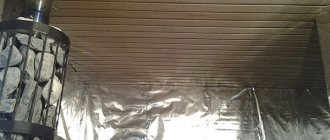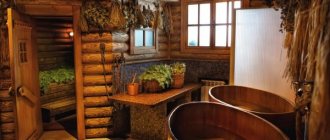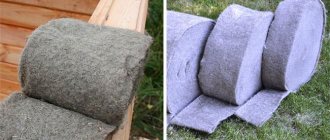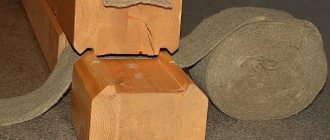A wooden bathhouse is the most common addition to a suburban area. You can build it yourself, but it is important to pay attention to a number of details. The insulation of a wooden bathhouse plays a very important role.
Only a competent approach guarantees that it will be truly comfortable to be in this room. Most modern buildings are built from logs or timber, but any of these materials requires proper insulation, and this can be done both from the inside and the outside.
What are the goals?
Initially, the baths were made of logs, and their insulation was carried out using improvised means, most often dry moss. Today, the insulation of a wooden bathhouse from the outside and inside is carried out with more modern materials that meet the necessary requirements and standards. The purpose of a bathhouse is to maintain heat at any outside temperature. That is why it is important to pay attention to design solutions in a specific project, namely the methods of connecting wooden elements and crowns, the location of the steam room, the size of windows and doors. But it is even more important to think through the insulation system - external and internal.
What materials?
There is a constant change in temperature and humidity in the bathhouse. Due to evaporation, moisture will accumulate on the surface of the walls, which is fraught with the appearance of fungus or microorganisms. To minimize such phenomena, it is important to competently approach the insulation of a wooden bathhouse from the inside. When choosing materials, you need to proceed from their technical characteristics, since in addition to thermal conductivity and moisture resistance, they must be environmentally friendly and natural.
Our ancestors used natural materials in the form of moss, clay, peat, flax fiber or tow as insulation. Today they have been replaced by synthetic materials, which are presented on the market in a huge variety.
It is preferable to use bitumen mastic or film as waterproofing, and various foil materials act as a good vapor barrier and at the same time insulation.
Slag
To produce slag wool, blast furnace slag is used as a raw material, which is previously processed into microfibers. During the production process, additives containing formaldehyde resins are added to cotton wool, which, as is known, release highly harmful substances when heated.
Among the advantages can be noted:
- Low cost.
- Resistance to rodents, fungus and mold.
- Easy installation
The disadvantages of slag wool do not allow its use for insulation in a bathhouse or sauna:
- Sudden temperature changes, which are typical for a steam room, lead to the product losing its thermal insulation qualities.
- The high hygroscopicity of the material will quickly lead to the loss of its function as a heat insulator.
- The increased fragility and thorniness of fibers dictates the presence of a protective mask and respirator when working.
- Slag wool is not able to withstand high loads and is deformed even under the influence of its own weight, sliding down over time if it is mounted in walls.
- Most importantly, slag wool contains phenol and formaldehyde in concentrations dangerous to humans, so using it indoors is extremely undesirable.
Insulation during the assembly of the log house
Insulation of a steam room in a wooden bath should begin when assembling the log house. For good thermal insulation, you need to lay tow, jute fiber or moss between logs or beams, or you can combine them. Only after six months will it be possible to perform secondary insulation, paying close attention to all seams.
When laying a building, attention is immediately paid to insulating the floors, especially if they are not made of wood, but concrete. In this case, labor-intensive work will be required: priming and leveling the surface, pouring sand, expanded clay and pouring the main floor.
Ceiling
The very first job is to insulate the wooden ceiling in the bathhouse: it bears the entire load in the form of heat and steam. Finishing the ceiling space involves laying a significant heat-insulating layer - in a steam room it can reach 15 cm, plus you need to lay a vapor barrier membrane. It is advisable to use foil in the steam room; for other rooms, thick polyethylene or kraft paper is sufficient. For wall cladding, it is advisable to use lining, wooden dies made of linden or aspen.
Ceiling insulation is carried out as follows:
- Sheets of rolled paper are placed overlapping on the surface of the ceiling and secured with tape and a stapler.
- Bars are placed across the paper, which should be thicker than the insulation used. It is better if mineral wool or slag fiber serves as insulation. The dressing room and sink ceilings are insulated with expanded clay, sand or sawdust.
- It is necessary to lay mats in the sheathing.
- The next layer is aluminum foil, the joints of which are carefully but tightly taped.
- The sheathing is already attached to the foil, and the front cladding is performed on it.
Foil insulation
Foil insulation based on mineral wool
Whatever type of insulation is chosen, a vapor barrier film must be laid during its installation. Foil insulation combines both vapor barrier and thermal insulation. But besides this, it also works as a reflector of thermal radiation, preventing heat from escaping through various cracks and loose fittings of structures. The material is manufactured in various versions:
- from basalt fiber;
- foamed polyethylene;
- mineral material;
- extruded polystyrene foam.
Foil insulation made of foamed polyethylene.
The thinnest aluminum foil is glued to each material on top. The shiny side of the insulating material should face the inside of the room. Can be used for all bath structures and premises.
Walls
Insulating walls in a steam room involves working from the ceiling and down to the floor . It is important to impregnate the walls before finishing, then seal the cracks with sealant and plaster. The best thermal insulators for walls are gypsum fiber or magnesite boards. Foil materials are used as a vapor barrier layer, which need to be stretched over the walls and also covered with the ceiling. The sheathing is already laid on this layer, and the sheathing is fixed on it.
The steam room is an important room in the bathhouse, so its insulation must be approached competently. For these purposes, experts advise choosing materials that will withstand exposure to high humidity and equally high temperatures. Moreover, the process of thermal insulation itself involves not only installing insulation, but also thinking through 2 additional layers at once - vapor and waterproofing. It is equally important that the ventilation system in the steam room is thought out.
How to reduce heat costs
You can avoid additional costs for insulating a bathhouse if you take care at the construction stage:
- installation of two- or three-chamber double- glazed windows (windows are a source of heat loss);
- making a high threshold into the steam room and, if possible, a low door (eliminates possible draft through the gap at the bottom of the door);
- using stones for the heater: recommended stones for each type of stove increase its heat capacity;
- the layout of the bathhouse (it is advisable that the steam room does not have a direct exit from the bathhouse, this will impede the flow of cold air);
- Decide on the question of what insulation to use for a bath in a steam room.
Floors
You need to start finishing with insulating the floor in the waiting room of a wooden bath. In this process, the choice of material plays an important role, since thanks to it the most comfortable temperature in the room will be maintained. Often, when treating the floor, foil polyethylene is used, which minimizes the temperature difference between the outside and the inside. External cladding can act as additional thermal insulation.
The floor in a modern bathhouse can be wooden, as was customary in the old days, or concrete. Accordingly, the methods of their insulation will vary significantly. Insulating the floor of a wooden bathhouse based on a concrete screed involves the use of perlite, glass wool or expanded clay, and these materials are laid between two layers of concrete covering. If the insulation is perlite, it is mixed directly with the concrete mixture.
Expanded polystyrene is a good alternative to these materials - slabs of different thicknesses are produced in different brands. The popularity of their use for finishing concrete floors is explained by their lightness, wear resistance, excellent thermal insulation properties and cost-effectiveness of use.
If the floor is made of wood...
Wooden floors in bathhouses are much more common, although concrete floors are better in performance. But wood always attracts attention due to its naturalness, environmental friendliness, and preservation of heat in the room.
When properly treated with various means, such coatings can last for a long time. Wood floors are very similar in construction to concrete subfloors, but instead of floor slabs, they are built on beams. The insulation material is placed above the subfloor, and slag, mats, mineral wool, and sand can be used in this capacity.
It is very popular today to insulate the floor of a wooden bath with Penofol..
It is a multilayer material with good reflective insulation properties due to the foil base and polyethylene foam. The peculiarity of the material is that it can be used for finishing baths even in harsh climatic conditions.
High thermal insulation characteristics
Two features make LOGICPIR insulation most effective:
- record low thermal conductivity coefficient of 0.022 W/m•K;
- high reflection coefficient - from 95 to 98%.
The material belongs to the class of reflective thermal insulation - it fully complies with the requirements of GOST R for reflective thermal insulation. That is, it allows you to retain radiant heat from the stove, save its energy, effectively reduce heat loss in the room, and at the same time does not absorb moisture at all.
External insulation
The wooden bath itself looks both modern and presentable, which is explained by the natural qualities of this material. Many people do not even finish the exterior of the building, although this will not only give an aesthetic appearance, but will also ensure a stable thermal regime inside the room. Experts still advise performing external insulation, even if the winters in a particular region are mild. Moreover, insulation can be done after the log house has shrunk. Do not forget that most of the heat leaves the room through the corners, so all joints must be processed as carefully as possible.
External insulation also requires attention to the attic. The ceilings in this room can be covered with glass hydroisol, covered with expanded clay or slag, and mats laid. The facade can be insulated using ventilated facade technology, which is built in several stages:
- The sheathing frame is formed depending on the thickness of the insulation that will be placed on it.
- The insulation material is laid in the sheathing, which is also supplemented with a diffuse membrane.
- The façade is covered with various materials.
Additional insulation should be applied to windows, especially areas located at the bottom of the wall. It is best to install triple-glazed windows in the window openings, not forgetting to carefully process and seal all the seams. In the dressing room you need to install an insulated door through which the cold will not penetrate inside in winter.
Practical advice
Experienced craftsmen have formulated several tips for those who decide to insulate a steam room with their own hands:
- Window design. To reduce heat loss from windows, it is better to make them small and carefully insulate the opening and slopes. In addition, they need to be placed lower so that the hottest air does not touch them. At the same time, condensation on the glass will be reduced. Multi-chamber metal-plastic windows should be installed to reduce heat loss through the frame.
- The doorway should be low, with a high threshold. This will reduce the outflow of warm air through the upper part and the influx of cold air through the lower part of the opening.
- You should select the furnace power corresponding to the area of the steam room. It is also important to place a sufficient amount of stones in the heater. To speed up heating and increase heat transfer, stones are placed in special wire mesh around the chimney or firebox body.
A properly insulated steam room warms up quickly and retains heat for a long time. It is cozy and comfortable, fuel is consumed economically. If a home craftsman has the skills of general construction work and follows the recommendations given, he can easily insulate the steam room with his own hands.











